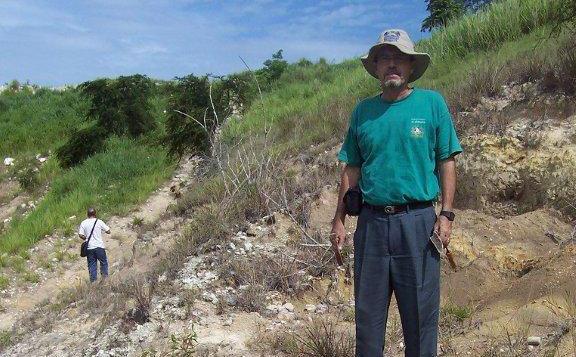
Born in Caguazal, hunted in present-day Ciego de Ávila province, Reinaldo Rojas Consuegra said that his childhood spent in the countryside greatly influenced his early curiosity towards nature.
“I taught an elementary school in a country school reached by an uncomfortable dirt road, but by a landscape of multi-colored butterflies, attractive birds and intensely green plants, which, unfortunately, are almost no longer there.”
For Guajirito whose family lived in a shack with dirt floors, wooden walls, guano roof and no electricity, getting a scholarship to a recently opened elementary school in the countryside was a great thing. It was there that the types of rocks in the different cropping areas in which they worked began to attract his attention, and his interest in soils, minerals, and fossils appeared.
This tendency was demonstrated when he entered the Pre-University Institute of the Field (Ipuec), in Ceballos, when he found in the school library a voluminous book on geology by authors Bermudó Meléndez and José María Foster.
“I read it completely, even without understanding a lot of things, but it caught my eye. So I decided to be a geologist.
He attended Moa University, Holguin, and received notice that he was accepted into Baku State University, in the Republic of Azerbaijan, where he completed his studies in May 1986, when he graduated as a geological engineer.
His dissertation dealt with gold prospecting and reserve calculation in the Florencia-Guáimaro-Camagüey deposits.
cling to search
With a 35-year dedication to geological studies, Dr. Rojas Consuegra has been involved as researcher or leader of nearly 40 national or international research projects.
“I began my working life associated with detailed geological survey and search for minerals in the Ciego-Camagüey region, but with the special period the project was interrupted, and I had to come to Havana, where I worked at the then Felipe Poey Museum, at the Academy of Sciences. My reunion there with Earth science paradigmist Manuel Ettoraldi Vinient has influenced the change my career will experience.
“Ituraldi established the Geology and Paleontology Collection within the so-called National Museum of the Natural History of Cuba, which formed my direct relationship with the fossils, scientific collections, scientific publishing and education.”
I stayed there for over 25 years. He was curator of paleontology, researcher, deputy scientific director and finally director, and although he has been working as chief specialist at the Ceinpet Petroleum Research Center (Ceinpet) for more than five years, he maintains relations with the museum which he considers his second alma mater.
At that time, he received a master’s degree in geology from Pinar del Rio University. He then received his PhD in Geosciences from the José Antonio Echeverria Polytechnic Institute, today the Technological University of Havana, and finally received the class of Senior Researcher in 2015.
He describes the experience at the Museum as exceptional and unforgettable, by teaching, for more than a decade, several children’s summer courses on excavations in Cuba, as well as his involvement in postgraduate teaching and paleoclimate studies, together with Professor Jesus Pagon Morejón, an authority in this subject.
Deserving the Carlos J. Finlay Medal, the State Council’s highest honor in the science sector, Dr. Reinaldo Rojas is the lead author of the first fossil record with visible dimensions found in Cuba since the 18th century.
He explained that it is a compendium that collects all the information generated in the country on paleontology over a period of more than 200 years; Data of great value for knowledge of the origin of Cuban plants and animals, patterns of species evolution, abundance of each group of organisms by geological periods, contributing to the knowledge of the fossil heritage.
The work is also a source of practical use for teaching at different levels of education, and contributes to the formation of a scientific culture.
Among the records in the collection are those related to the origin of Cuba and the presence of many mollusks, fish, birds and mammals in past times, including monkeys, sloths, whales and other animals that have disappeared from our environment.
Another topic examined by Professor Rojas Consuegra is that topic that refers to the search for possible evidence, in the Cuban archipelago, of an asteroid impact, which occurred about 66 million years ago, in the present-day Yucatan Peninsula, and the meaning of this event for the geological evolution of the Cuban soil, which is related exploring hydrocarbons.
He noted that as part of a project carried out jointly with specialists from the University of Tokyo (providing advanced laboratory techniques), it was possible to collect an abundant sample of rock elements that, once analyzed, led us to suggest that Cuba contains most of the rock formations associated with violent collision.
The most notable discovery is the location of several notable rocks of the Cretaceous-Paleogene boundary (dating about 65 million years ago) at various points in national geography, with a thickness greater than that observed in other countries of the Caribbean. And more bountiful.
Associated with the oil sector since joining Ceinpet, just over five years ago, Rojas Consuegra is involved in projects funded by the Geological Modernization Program in Cuba. Through its implementation, it seeks to save and update the available information about deep wells that were drilled long ago. At least four exploration blocks and about 40 wells have already been evaluated.
He stressed that in the near term, together with other Ceinpet specialists, we are developing the 1:50,000 scale geological map, in detail, from the Varadero paper, which we should finish in 2023.

“Social media evangelist. Student. Reader. Troublemaker. Typical introvert.”

:quality(85)/cloudfront-us-east-1.images.arcpublishing.com/infobae/TEQF6EONZRFGLLLDIDD4L2O4EE.jpg)

:quality(75)/cloudfront-us-east-1.images.arcpublishing.com/elcomercio/XU32LRAEZFDDPNVHLFU3CKVBYY.jpg)



More Stories
Venezuela ranks fourth in female leadership in science and technology in Latin America
In Portuguesa and Sucre they explore the wonderful world of science
The university court overturns the expulsion of two teachers and a chemical sciences student